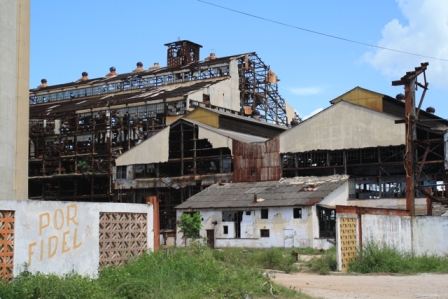Hershey: The Cuban Comala
Alfredo Fernandez Rodriguez

In the now classic novel Pedro Paramo, by Mexican writer Juan Rulfo, in the town of Comola everyone is dead. Today the Cuban reality of a small town 28 miles to the east of Havana outstrips any work of fiction.
One needs only walk the streets of the old village of Hershey, today named “Camilo Cienfuegos.” With each step, the houses —once similar to those of the “Chocolate City” of Hershey, Pennsylvania— are now found deteriorated. They languish in the wake of a past that was as prosperous as it was luxurious.
Even those people who never met Mr. Hershey himself, speak highly of him in respect for his glorious accomplishments in Cuba from 1916 to 1946, when, among other things, he was behind the building of one of the most prosperous sugar refineries the island ever saw.
In addition to the refinery, he was also responsible for the local peanut oil plant, a henequen plant, and 251 kilometers of railroad over which trains moved (and still do today) by electric energy. With the revolutionary victory in 1959, the refinery and its batey* were re-baptized with the name of rebel army commandant Camilo Cienfuegos.
After walking through the town and talking with its old-timers, who boast of having been sugar workers all their lives, a powerful sadness is seen in their eyes when they look at the sugar mill (or any other place in town) as day by day it slowly transforms into a scrapheap.
The village is deteriorating along with the mill, and in turn both along with the area’s residents, who yearn for a past splendor that is now very much remote. Void of purpose, the residents seem dead, like those of Comala.
The non-existence of the sugar harvest has left this place without a reason for being. Today, however, not only is sugar returning to demand an excellent price on the world market, but so are sugar cane derivatives.
The present of the town of Hershey, or “Camilo Cienfuegos” (you can call it what you like) discredits the pragmatism of a chocolate magnate such as Mr. Hershey just as it detracts from the inveterate joy of the “Lord of the Vanguard,” Camilo Cienfuegos.
* A town built up around a sugar mill and which is generally made up of the workers in that industry.






A group of Swiss entrepreneurs proposes the restoration and transformation of Hershey – within the respect of the old structures – in an industrial theme park that will not only be an industrial museum, but rather become a place where the tourists can see and experiment the history of the sugar cane production with all the many stages of processing, including the historical electrical train. This sustainable project is also focusing and giving priority to the local trade (food supply, manufacturers, souvenirs, etc). The park will offer the visitors various options of activities, excursions and lodging as well as restaurants and bars. There will also be options for sports and recreation, concerts, theatre and an event hall.
Negotiations with the cuban authorities though have come to a temporary halt, due to that the officials give other projects higher priority. There is website http://www.transhershey.com which gives the full story.
Before he died, I sent my wife’s uncle, who worked for Hershey for many years, fotos of Hershey/Camilo Cienfuegos. I was able to spend a bit of time in the Cuban town when the Tren Hershey was held up at the station there due to mechanical difficulties. Like its Cuban counterpart, Hershey, Pennsylvania, has gone into decline, as the company has recently outsourced much of its production. Perhaps the Hershey Company can once again reopen their (former) Cuban central, this time as a joint venture company. If you take the train down the Connecticut Valley from Springfield, Massachusetts, to New Haven, Connecticut, you will see many cities and towns which, like Hershey, Cuba, have been “deindustrialized,” with consequent disasterous results. Many of these companies first moved their factories from New England to the South, in the 1950’s and 1960’s, to avoid unionized labor. Later, in the 1980’s and 1990’s, producton again moved from the South to China, and now to such nations as Bangladesh, where labor is even cheaper.